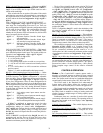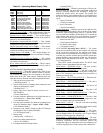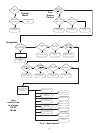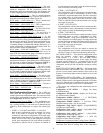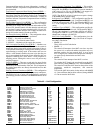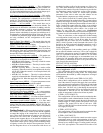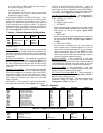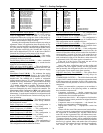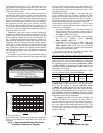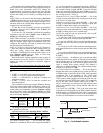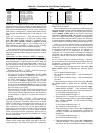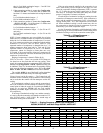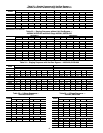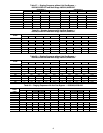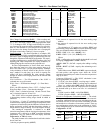
40
temperature (OAT) rises above 75 F or the highest active cir-
cuit saturated condensing temperature (SCT) rises above the
HPSP and remains on until the condition is repaired regardless
of the OAT and SCT values.
Any time the alert occurs, a strike is called out on the affect-
ed compressor. If three successive strikes occur the compressor
will be locked out requiring a manual reset or power reset of
the circuit board. The clearing of strikes during compressor op-
eration is a combination of 3 complete cycles or 15 continuous
minutes of run time operation. If there are one or two strikes on
the compressor and three short cycles (ON-OFF, ON-OFF,
ON-OFF) less than 15 minutes each occur, the strikes are reset
to zero for the affected compressor. If the compressor turns on
and runs for 15 minutes straight with no compressor failure, the
compressor strikes are cleared.
Additionally, some units contain Copeland compressors
equipped with advanced scroll temperature protection (ASTP).
A label located above the terminal box identifies Copeland
Scroll compressor models that contain this technology. See
Fig. 5. Advanced scroll temperature protection is a form of in-
ternal discharge temperature protection that unloads the scroll
compressor when the internal temperature reaches approxi-
mately 300 F. At this temperature, an internal bi-metal disk
valve opens and causes the scroll elements to separate, which
stops compression. Suction and discharge pressures balance
while the motor continues to run. The longer the compressor
runs unloaded, the longer it must cool before the bi-metal disk
resets. See Fig. 6.
To manually reset ASTP, the compressor should be stopped
and allowed to cool. If the compressor is not stopped, the motor
will run until the motor protector trips, which occurs up to
90 minutes later. Advanced scroll temperature protection will
reset automatically before the motor protector resets, which
may take up to 2 hours.
COMPRESSOR TIME GUARDS — The control will not al-
low any output relay to come on within 3 seconds of any other
output relay. For outputs connected to the compressors, the con-
trol will use a Compressor Minimum OFF Time of 2 minutes, a
Compressor Minimum ON Time of 3 minutes and a Minimum
Delay before turning on another compressor of 10 seconds.
COOL MODE SELECTION PROCESS — The A Series
ComfortLink™ controls offer three distinct methods by which
it may select a cooling mode.
1. Thermostat (C.TYP=3 and 4): The thermostat does not
depend upon the state of occupancy and the modes are
called out directly by the discrete inputs from the thermo-
stat (Inputs
STAT
Y1 and Y2).
2. Occupied VAV cooling types (C.TYP=1 and 2) are called
out in the occupied period (Operating
Modes
MODE
OCC=ON).
3. Unoccupied VAV cooling types (C.TYP=1 and 2) are
called out in the unoccupied period (Operating
Modes
MODE
OCC=OFF). They are also used for
space sensor control types (C.TYP=5 and 6) in both the
occupied and unoccupied periods.
This section is devoted to the process of cooling mode
determination for the three types outlined above.
VAV Cool Mode Selection during the Occupied Period
(C.TYP = 1,2 and Operating Modes
MODE
OCC =ON)
— There is no difference in the selection of a cooling mode for
either VAV-RAT or VAV-SPT in the occupied period. The actual
selection of a cool mode, for both control types, is based upon
the controlling return-air temperature (Temperatures
AIR.T
CTRL
R.TMP). Typically this is the same as the return air
temperature thermistor (Temp eratures
AIR.T
RAT) except
when under CCN Linkage.
VAV Occupied Cool Mode Evaluation Configuration — There
are VAV occupied cooling offsets under Setpoints.
Cool Mode Determination — If the machine control type
(Configuration
UNIT
C.TYP) = 1 (VAV-RAT) or 2 (VAV-
SPT) and the control is occupied (Operating Modes
MODE
OCC=ON), then the unit will not follow the occu-
pied cooling set point (OCSP). Instead, the control will follow
two offsets in the determination of an occupied VAV cooling
mode (Setpoints
V.C .ON and Setpoints
V.C .OF), applying
them to the low-heat off trip point and comparing the resulting
temperature to the return-air temperature.
The Setpoints
V.C .ON (VAV cool mode on offset) and
Setpoints
V. C. OF (VAV cool mode off offset) offsets are
used in conjunction with the low heat mode off trip point to
determine when to bring cooling on and off and in enforcing a
true “vent” mode between heating and cooling. See Fig. 7. The
occupied cooling set point is not used in the determination of
the cool mode. The occupied cooling set point is used for
supply air reset only.
ITEM EXPANSION RANGE UNITS CCN POINT DEFAULT
V. C.ON VAV Occ.
Cool On Delta
0-25 ^F VAVOCON 3.5
V. C.OF VAV Occ.
Cool Off Delta
1-25 ^F VAVOCOFF 2
0
10
20
30
40
50
60
70
80
90
100
110
120
0 102030405060708090
Compressor Unloaded Run Time (Minutes)
Recommended Cooling Time
(Mi
nut
es)
*Times are approximate.
NOTE: Various factors, including high humidity, high ambient tem-
perature, and the presence of a sound blanket will increase cool-
down times.
Fig. 6 — Recommended Minimum Cool-Down
Time After Compressor is Stopped*
Fig. 5 — Advanced Scroll Temperature
Protection Label
L.H.OF
L.H.ON
V.C. ON
V.C. OF
OHSP
Fig. 7 — VAV Occupied Period Trip Logic
A48-7700



